The Dry Deposition Effect of PM2.5 in Urban Green Spaces of Beijing, China
Abstract
1. Introduction
2. Materials and Methods
2.1. Study Area
2.2. Data Sources and Processing
2.2.1. Remote Sensing Data
2.2.2. PM2.5 Concentration Data
2.2.3. Wind Speed and Precipitation Data
2.2.4. Leaf Area Index Data
2.3. Research Methods
2.3.1. Dry Deposition Estimation Method for Forested and Grassland Areas
2.3.2. Estimation Methods for PM2.5 Particle Deposition Rates on Farmland
2.3.3. Estimation Methods for Dry Settling Rates of Water, Impervious Surfaces, and Unutilized Land
2.3.4. Removal Efficiency Estimation Method
3. Results
3.1. PM2.5 Data Accuracy Validation
3.2. PM2.5 Deposition Efficiency by Land Type
3.3. Characteristics of Changes in PM2.5 Dry Deposition Time in Urban Green Spaces
3.3.1. Interannual Variation Characteristics of PM2.5 Dry Deposition in Urban Green Spaces
3.3.2. Seasonal Variations in PM2.5 Dry Deposition in Urban Green Spaces
3.3.3. Monthly Variation Characteristics of PM2.5 Dry Deposition in Urban Green Spaces
3.4. Spatial Variation Characteristics of PM2.5 Dry Deposition in Urban Green Spaces
4. Discussion
4.1. Urban Green Spaces Exhibit a Significant Temporal Effect on PM2.5 Dry Deposition
4.2. PM2.5 Dry Deposition in Urban Green Spaces Exhibits Significant Spatial Distribution Characteristics
4.3. Optimization Recommendations for Urban Green SpacesUrban Green Space Optimization Strategies and PM2.5 Dry Deposition Effect Prediction
4.3.1. Optimization Recommendations for Urban Green Spaces
- (1)
- Optimize the Layout of Green Space Types: Prioritize the Configuration of Vegetation with High-Efficiency Deposition
- (2)
- Refine Spatial Layout, Leverage Spatial Heterogeneity, and Maximize Deposition Efficiency
- (3)
- Adapt to Seasonal Patterns: Enhance Temporal Matching of Deposition Capacity
4.3.2. Prediction of Optimization Strategy Effects
- (1)
- Scenario 1: Status Quo Continuation (No Optimization Measures)
- (2)
- Scenario 2: Implementation of Optimization Recommendations
5. Conclusions
Author Contributions
Funding
Institutional Review Board Statement
Informed Consent Statement
Data Availability Statement
Acknowledgments
Conflicts of Interest
References
- Wang, C.; Hao, L.; Liu, C.; Chen, R.; Wang, W.; Chen, Y.; Yang, Y.; Meng, X.; Fu, Q.; Ying, Z.; et al. Associations between fine particulate matter constituents and daily cardiovascular mortality in Shanghai, China. Ecotoxicol. Environ. Saf. 2020, 191, 110154. [Google Scholar] [CrossRef]
- Hutsemékers, V.; Mouton, L.; Westenbohm, H.; Collart, F.; Vanderpoorten, A. Disentangling climate change from air pollution effects on epiphytic bryophytes. Glob. Change Biol. 2023, 29, 3990–4000. [Google Scholar] [CrossRef] [PubMed]
- Wang, X.; Dewancker, B.J.; Tian, D.; Zhuang, S. Exploring the burden of PM2.5-related deaths and economic health losses in Beijing. Toxics 2024, 12, 377. [Google Scholar] [CrossRef] [PubMed]
- Schwartz, J.; Neas, L.M. Fine particles are more strongly associated than coarse particles with acute respiratory health effects in schoolchildren. Epidemiology 2000, 11, 6–10. [Google Scholar] [CrossRef] [PubMed]
- Zhao, Y.Y.; Zhang, X.P.; Chen, M.X.; Gao, S.S.; Li, R.K. Regional variation of urban air quality in China and its dominant factors. Acta Geogr. Sin. 2021, 11, 2814–2829. [Google Scholar] [CrossRef]
- Wang, S.; Zhou, C.; Wang, Z.; Feng, K.; Hubacek, K. The characteristics and drivers of fine particulate matter (PM2.5) distribution in China. J. Clean. Prod. 2017, 142, 1800–1809. [Google Scholar] [CrossRef]
- Liu, H.; Li, X.M.; Tian, S.C.; Li, S.B.; Gong, Y.L. Study on Spatio-Temporal Evolution and Influencing Factors of Urban Air Quality in China. Ecol. Econ. 2021, 7, 91–96. [Google Scholar]
- Perez, P.; Menares, C.; Ramírez, C. PM2.5 forecasting in Coyhaique, the most polluted city in the Americas. Urban Clim. 2020, 32, 100608. [Google Scholar] [CrossRef]
- Wang, Z.F.; Wang, X.K.; Xie, X.Q.; Xiao, M.H.; Wu, Y.F.; Liu, X.S. Evolution of Landscape Pattern of Green Space in Fujian Province: Influencing Factors and Spatial Differences Based on GWR Model. J. Northwest For. Univ. 2022, 5, 242–250. [Google Scholar]
- Lin, L.; Yan, J.; Ma, K.; Zhou, W.; Chen, G.; Tang, R.; Zhang, Y. Characterization of particulate matter deposited on urban tree foliage: A landscape analysis approach. Atmos. Environ. 2017, 171, 59–69. [Google Scholar] [CrossRef]
- Millward, A.A.; Sabir, S. Benefits of a forested urban park: What is the value of Allan Gardens to the city of Toronto, Canada? Landsc. Urban Plan. 2011, 100, 177–188. [Google Scholar] [CrossRef]
- Toparlar, Y.; Blocken, B.; Maiheu, B.; Van Heijst, G.J.F. The effect of an urban park on the microclimate in its vicinity: A case study for Antwerp, Belgium. Int. J. Climatol. 2018, 38, e303–e322. [Google Scholar] [CrossRef]
- Thompson, C.W.; Roe, J.; Aspinall, P. More green space is linked to less stress in deprived communities: Evidence from salivary cortisol patterns. Landsc. Urban Plan. 2012, 105, 221–229. [Google Scholar] [CrossRef]
- Tu, X.Y.; Huang, G.L.; Wu, J.G. Review of the relationship between urban greenspace accessibility and human well-being. Acta Ecol. Sin. 2019, 2, 421–431. [Google Scholar] [CrossRef]
- He, D.; Yuan, J.Q.; Gao, Z.F.; Li, C.M.; Lei, K.Y.; Liu, Y.P.; Dong, N.L. Effects of leaf surface microstructure of 13 evergreen shrubs on atmospheric particulate retention capacity in Zhengzhou City. J. Zhejiang AF Univ. 2025, 3, 513–523. [Google Scholar]
- Wang, J.; Xu, H.Y.; Yue, F.; Fu, F. Research on the Correlation Between Green Space Layout and PM2.5 in the Central Urban Area of Beijing. J. Beijing Univ. Civ. Eng. Archit. 2023, 1, 44–52. [Google Scholar]
- Chen, M.; Yang, C.; Dai, F. Effects of Urban Park Green Spaces and Surrounding Built Environments on PM2.5:A Case Study of Ten Park Green Spaces in Wuhan. Chin. Landsc. Archit. 2023, 10, 104–110. [Google Scholar]
- Qiu, L.; Liu, F.; Zhang, X.; Gao, T. Difference of airborne particulate matter concentration in urban space with different green coverage rates in Baoji, China. Int. J. Environ. Res. Public Health 2019, 16, 1465. [Google Scholar] [CrossRef]
- Badach, J.; Dymnicka, M.; Baranowski, A. Urban vegetation in air quality management: A review and policy framework. Sustainability 2020, 12, 1258. [Google Scholar] [CrossRef]
- Fang, J.; Li, S.; Zhao, N.; Xu, X.; Zhou, Y.; Lu, S. Uptake and distribution of the inorganic components NH4+ and NO3− in PM2.5 by two Chinese conifers. Sci. Total Environ. 2024, 907, 167573. [Google Scholar] [CrossRef] [PubMed]
- Lee, A.; Jeong, S.; Joo, J.; Park, C.R.; Kim, J.; Kim, S. Potential role of urban forest in removing PM2.5: A case study in Seoul by deep learning with satellite data. Urban Clim. 2021, 36, 100795. [Google Scholar] [CrossRef]
- Zhai, C.; Bao, G.; Zhang, D.; Sha, Y. Urban forest locations and patch characteristics regulate PM2.5 mitigation capacity. Forests 2022, 13, 1408. [Google Scholar] [CrossRef]
- Giardina, M.; Donateo, A.; Buffa, P.; Contini, D.; Cervone, A.; Lombardo, C.; Rocchi, F. Atmospheric dry deposition processes of particles on urban and suburban surfaces: Modelling and validation works. Atmos. Environ. 2019, 214, 116857. [Google Scholar] [CrossRef]
- Li, J.X.; Han, L.J.; Zhang, Z.M.; Zhou, W.Q.; Li, W.F.; Qian, Y.G. Assessment on the reduction of atmospheric PM2.5 by urban forest and its ratio to the total PM2.5 pollutant in the Chinese major cities. Acta Ecol. Sin. 2023, 7, 2640–2649. [Google Scholar] [CrossRef]
- Chen, H.S.; Lin, Y.C.; Chiueh, P.T. High-resolution spatial analysis for the air quality regulation service from urban vegetation: A case study of Taipei City. Sustain. Cities Soc. 2022, 83, 103976. [Google Scholar] [CrossRef]
- Yao, J.; Wu, S.; Cao, Y.; Wei, J.; Tang, X.; Hu, L.; Wu, J.; Yang, H.; Yang, J.; Ji, X. Dry deposition effect of urban green spaces on ambient particulate matter pollution in China. Sci. Total Environ. 2023, 900, 165830. [Google Scholar] [CrossRef] [PubMed]
- Nowak, D.J.; Hirabayashi, S.; Bodine, A.; Hoehn, R. Modeled PM2.5 removal by trees in ten US cities and associated health effects. Environ. Pollut. 2013, 178, 395–402. [Google Scholar] [CrossRef]
- Akopov, A.S.; Beklaryan, L.A.; Saghatelyan, A.K. Agent-based modelling of interactions between air pollutants and greenery using a case study of Yerevan, Armenia. Environ. Model. Softw. 2019, 116, 7–25. [Google Scholar] [CrossRef]
- Junior, D.P.M.; Bueno, C.; da Silva, C.M. The Effect of Urban Green Spaces on Reduction of Particulate Matter Concentration. Bull. Environ. Contam. Toxicol. 2022, 108, 1104–1110. [Google Scholar] [CrossRef] [PubMed]
- Chen, P.X.P.; Jiao, Y.W.; Pei, T.T.; Zjou, Z.X. The effect of adsorbing fine particulate matter (PM2.5) by garden plants: A review. Chin. J. Ecol. 2014, 9, 2558–2566. [Google Scholar]
- Ma, Z.Y.; Xiao, H.W. The Research on A Spatial Differentiation of Influence Factors of Regional PM2.5 in China—The Empirical Analysis Based on Geographically Weighted Regression Model. J. Shanxi Univ. Financ. Econ. 2017, 5, 14–26. [Google Scholar]
- Editorial Board of China Statistical Yearbook. China Statistical Yearbook 2021; China Statistics Press: Beijing, China, 2022. [Google Scholar]
- Bai, K.; Li, K.; Wu, C.; Chang, N.B.; Guo, J. A homogenized daily in situ PM2.5 concentration dataset from national air quality monitoring network in China. Earth Syst. Sci. Data Discuss. 2020, 2020, 1–30. [Google Scholar] [CrossRef]
- Wang, J.; Endreny, T.A.; Nowak, D.J. Mechanistic simulation of tree effects in an urban water balance model. J. Am. Water Resour. Assoc. 2008, 44, 75–85. [Google Scholar] [CrossRef]
- She, X.; Gao, J.; Zhang, B. PM2.5 removal service of green spaces in Shanghai based on the dust retention simulation on urban vegetation. Acta Ecol. Sin. 2020, 40, 2599–2608. [Google Scholar] [CrossRef]
- Ren, Z.; Du, Y.; He, X.; Pu, R.; Zheng, H.; Hu, H. Spatiotemporal pattern of urban forest leaf area index in response to rapid urbanization and urban greening. J. For. Res. 2018, 29, 785–796. [Google Scholar] [CrossRef]
- Saunders, S.M.; Dade, E.; Van Niel, K. An Urban Forest Effects (UFORE) model study of the integrated effects of vegetation on local air pollution in the Western Suburbs of Perth, WA. In Proceedings of the 19th International Congress on Modelling and Simulation, Perth, Australia, 12–16 December 2011; pp. 12–16. [Google Scholar]
- Pullman, M. Conifer PM2.5 Deposition and Re-Suspension in Wind and Rain Events. Master’s Thesis, Cornell University, Ithaca, NY, USA, 2008. [Google Scholar]
- Zhang, L.; He, Z. An empirical algorithm estimating dry deposition velocity of fine, coarse and giant particles. Atmos. Chem. Phys. 2014, 14, 3729–3737. [Google Scholar] [CrossRef]
- Liu, C.Y.; Jin, H.; Fan, J.L. Input Characteristics of Dry Deposition of Atmospheric Particulates and Metals in Farmland in the Suburb of Nanjing. Huan Jing Ke Xue 2023, 44, 1873–1881. [Google Scholar]
- Zhao, X.; Yan, H.; Liu, M.; Kang, L.; Yu, J.; Yang, R. Relationship between PM2.5 adsorption and leaf surface morphology in ten urban tree species in Shenyang, China. Energy Sources Part A Recovery Util. Environ. Eff. 2019, 41, 1029–1039. [Google Scholar] [CrossRef]
- Nowak, D.J.; Civerolo, K.L.; Rao, S.T.; Sistla, G.; Luley, C.J.; Crane, D.E. A modeling study of the impact of urban trees on ozone. Atmos. Environ. 2000, 34, 1601–1613. [Google Scholar] [CrossRef]
- Liu, J.; Mo, L.; Zhu, L.; Yang, Y.; Liu, J.; Qiu, D.; Zhang, Z.; Liu, J. Removal efficiency of particulate matters at different underlying surfaces in Beijing. Environ. Sci. Pollut. Res. 2016, 23, 408–417. [Google Scholar] [CrossRef]
- Freer-Smith, P.H.; El-Khatib, A.A.; Taylor, G. Capture of particulate pollution by trees: A comparison of species typical of semi-arid areas (Ficus nitida and Eucalyptus globulus) with European and North American species. Water Air Soil Pollut. 2004, 155, 173–187. [Google Scholar] [CrossRef]
- Tallis, M.; Taylor, G.; Sinnett, D.; Freer-Smith, P. Estimating the removal of atmospheric particulate pollution by the urban tree canopy of London, under current and future environments. Landsc. Urban Plan. 2011, 103, 129–138. [Google Scholar] [CrossRef]
- Li, K.; Li, C.; Hu, Y.; Xiong, Z.; Wang, Y. Quantitative estimation of the PM2.5 removal capacity and influencing factors of urban green infrastructure. Sci. Total Environ. 2023, 867, 161476. [Google Scholar] [CrossRef]
- Fang, Y.H.; Zhao, L.Y.; Dou, B.Y.; Wang, S.X.; Zhou, C. Reduction effect of green infrastructure on PM2.5 in the built-up areas of urban agglomerations in the Yangtze River’s middle reaches. Acta Ecol. Sin. 2024, 1, 117–128. [Google Scholar]
- Hu, C.Y.; Wei, W.; Wang, X.F.; Chen, L.D.; Chen, X.N.; Ji, Y.Z. Change in Vegetation Cover as Affected by Grain for Green Project in Gansu. J. Ecol. Rural. Environ. 2016, 4, 588–594. [Google Scholar]
- Wang, K.P.; Zhang, Y.K.; Liu, X.H. Modeled Particulate Matters Removal by Urban Green Lands in Beijing. Environ. Sci. Technol. 2020, 4, 121–129. [Google Scholar]
- Zeng, X.P.; Zhao, P.; Rao, X.Q.; Cai, X.A. Measurement of leaf area index of three plantations and their seasonal changes in Heshan hilly land. J. Beijing For. Univ. 2008, 5, 33–38. [Google Scholar]
- Bo, X.Y.; Xie, D.H.; Wu, M.X.; Yan, G.J.; Mu, X.H. Leaf area index inversion corrected with clumping index of maize canopy. J. Beijing Norm. Univ. (Nat. Sci.) 2024, 2, 217–227. [Google Scholar]
- Duan, G.L.; Wang, W.J.; Cheen, W.W.; Wang, L.Y.; Xing, G.Q. Reach on Effect of Conservation Tillage on Suppressing Dustin Seasonal Bare Farmland. Agric. Sci. Technol. Equip. 2021, 5, 112–114. [Google Scholar]
- Qi, S.; Wang, C.; Niu, Z.; Liu, Z. SVI and VCI based on NDVI time-series dataset used to monitor vegetation growth status and its response to climate variables. Prog. Geogr. 2004, 23, 91–99. [Google Scholar]
- Zhang, Q.; Wu, S.Q.; Yang, X. A Quantitative Comparison on Green Pattern of Megalopolis Central Area: A Case of Beijing, London, Paris and New York. Huazhong Archit. 2017, 6, 16–23. [Google Scholar]
- Yang, X.; Zhang, Q.; Wu, S.Q. Comparative Research on Multi-scale and System of Metropolis Green Space Pattern: Case Studies of Beijing, London, Paris and New York. Urban Plan. Int. 2017, 3, 83–91. [Google Scholar] [CrossRef]
- Wu, J.S.; Xie, W.D.; Li, W.F.; Li, J. Effects of Urban Landscape Pattern on PM2.5 Pollution—A Beijing Case Study. PLoS ONE 2015, 10, e0142449. [Google Scholar] [CrossRef] [PubMed]
- Beijing Municipal Environmental Protection Bureau. Evaluation Report on the Implementation Effect of the Beijing Clean Air Action Plan (2013–2020); Beijing Municipal Environmental Protection Bureau: Beijing, China, 2021.
- Beijing Municipal Bureau of Statistics. Beijing Urban Statistical Yearbook 2024; China Statistics Press: Beijing, China, 2024. [Google Scholar]
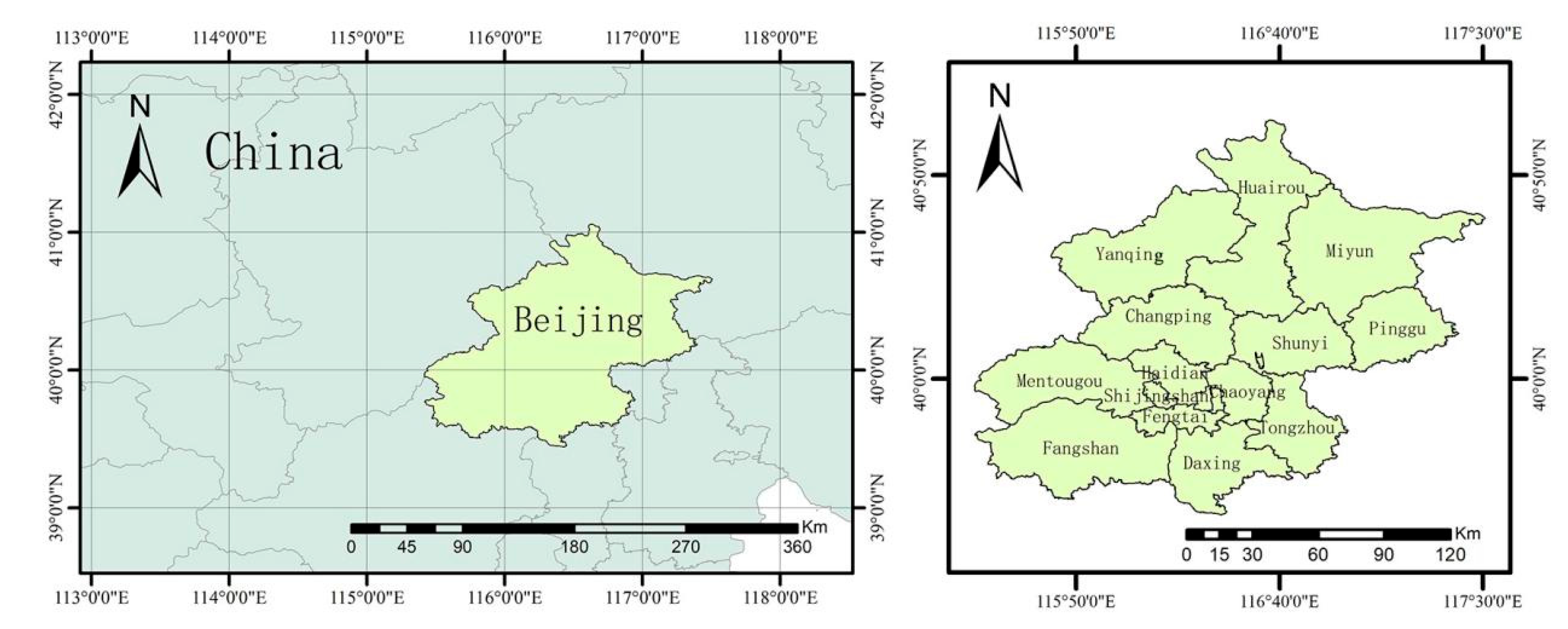
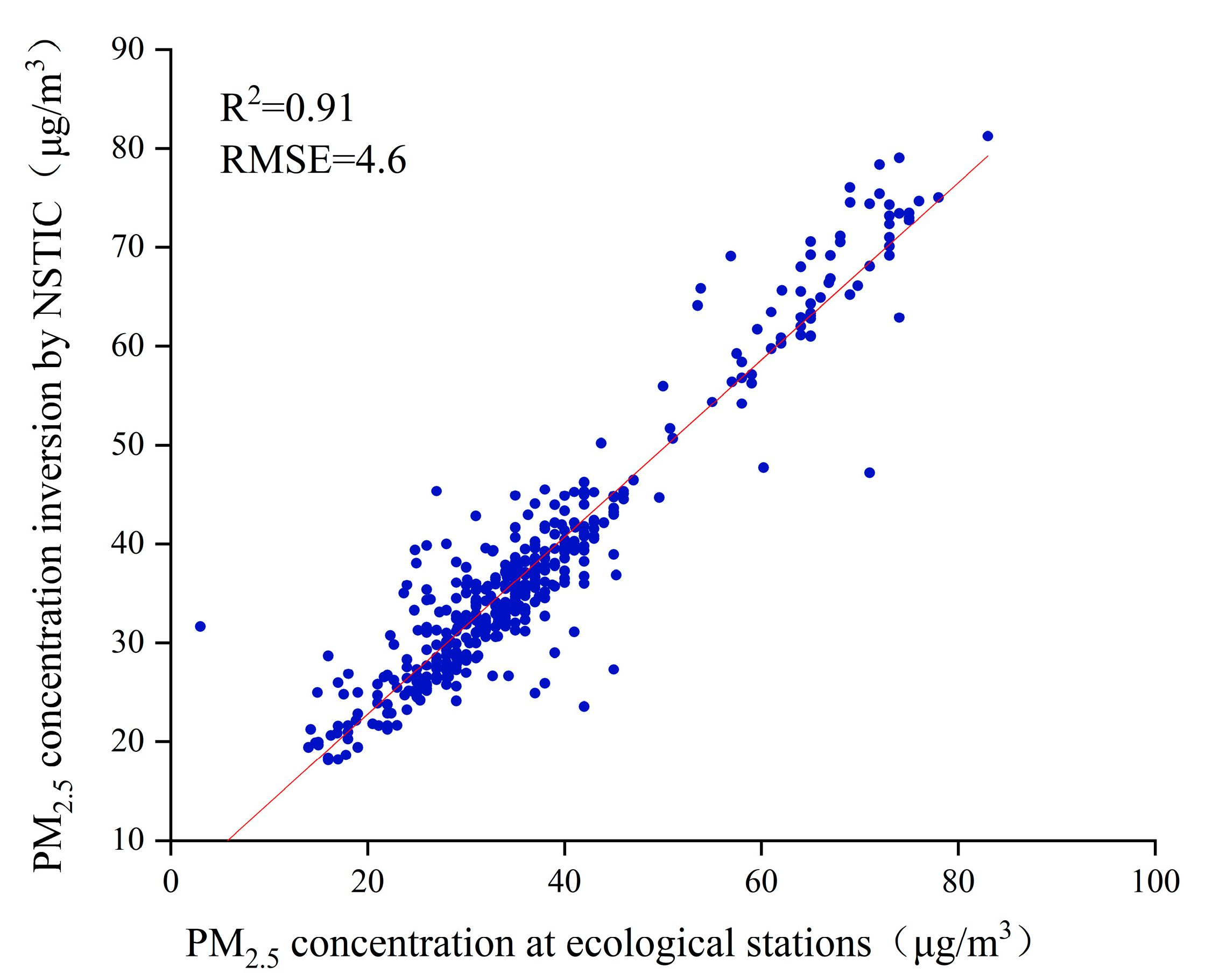
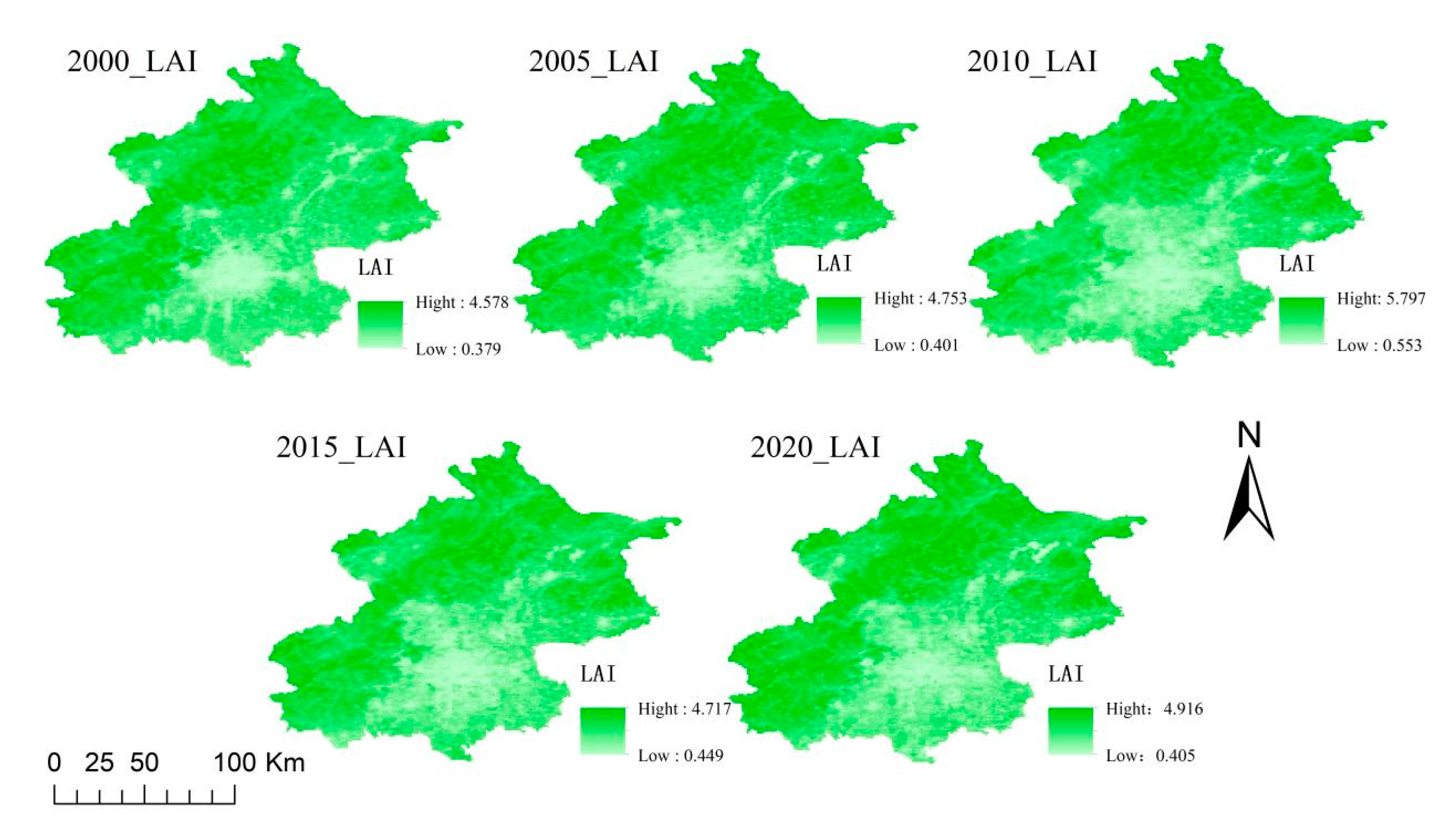

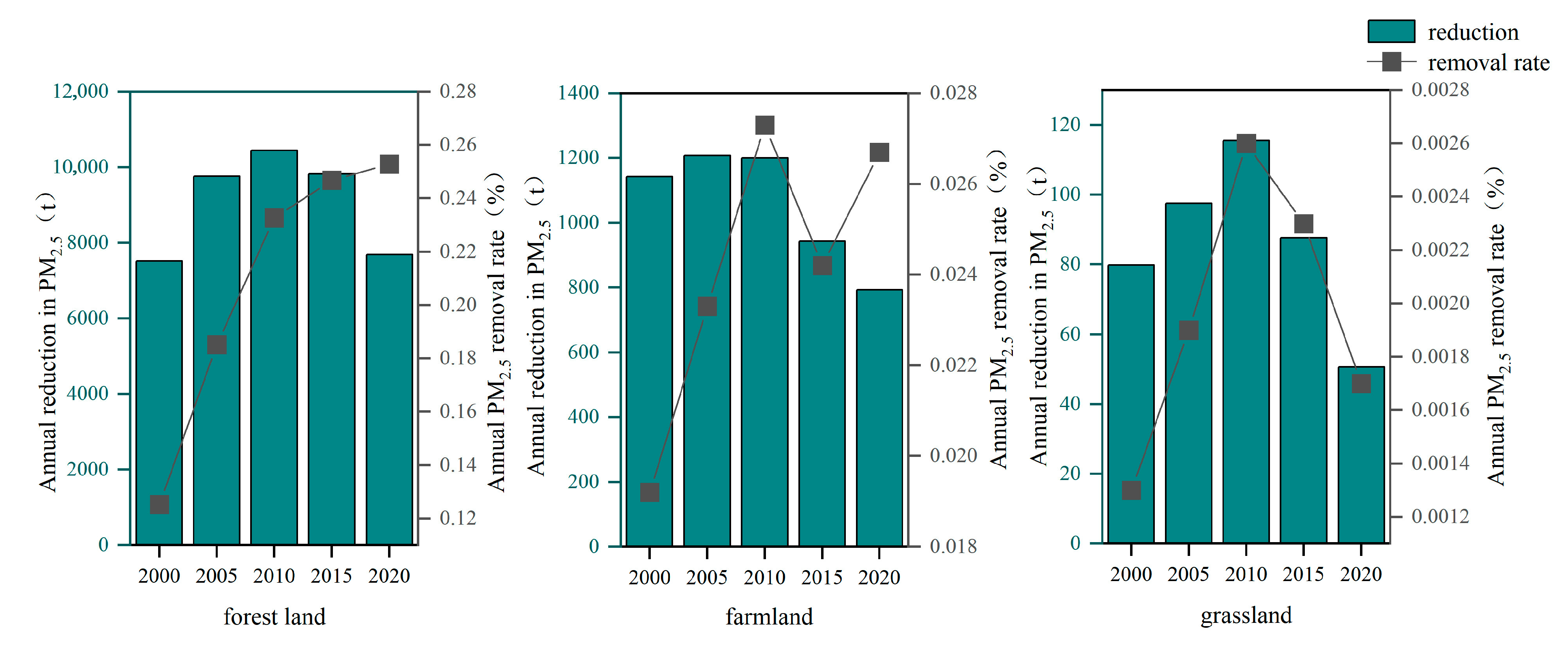
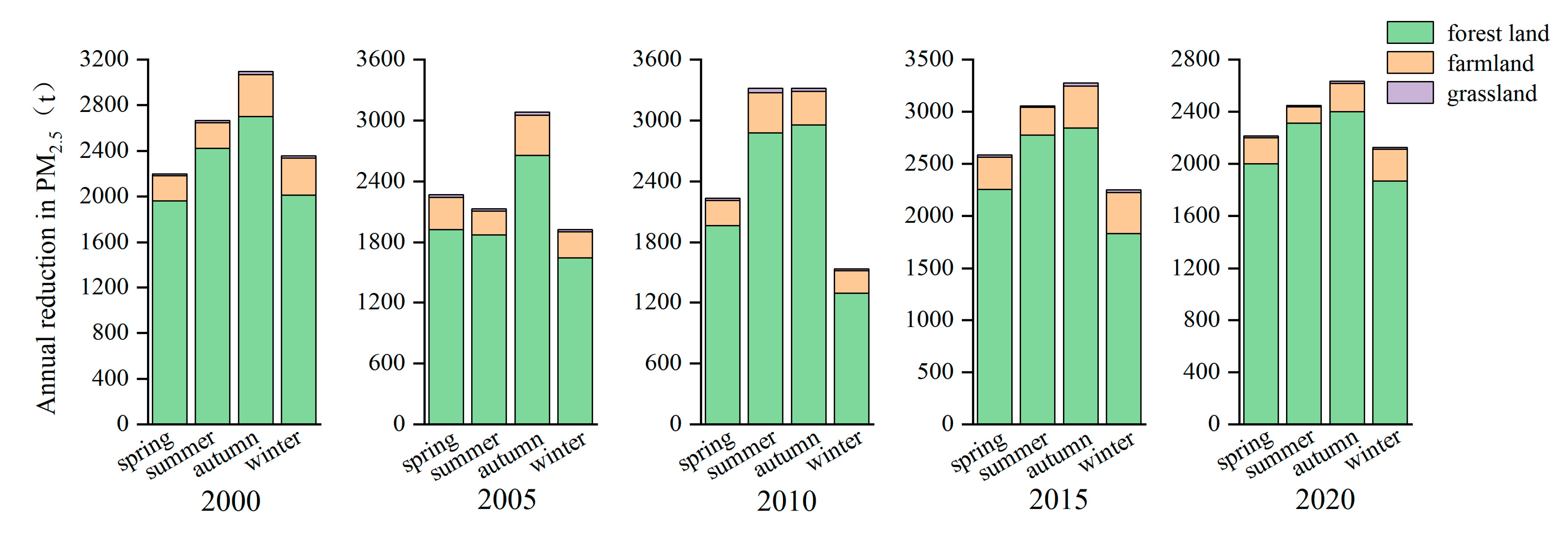
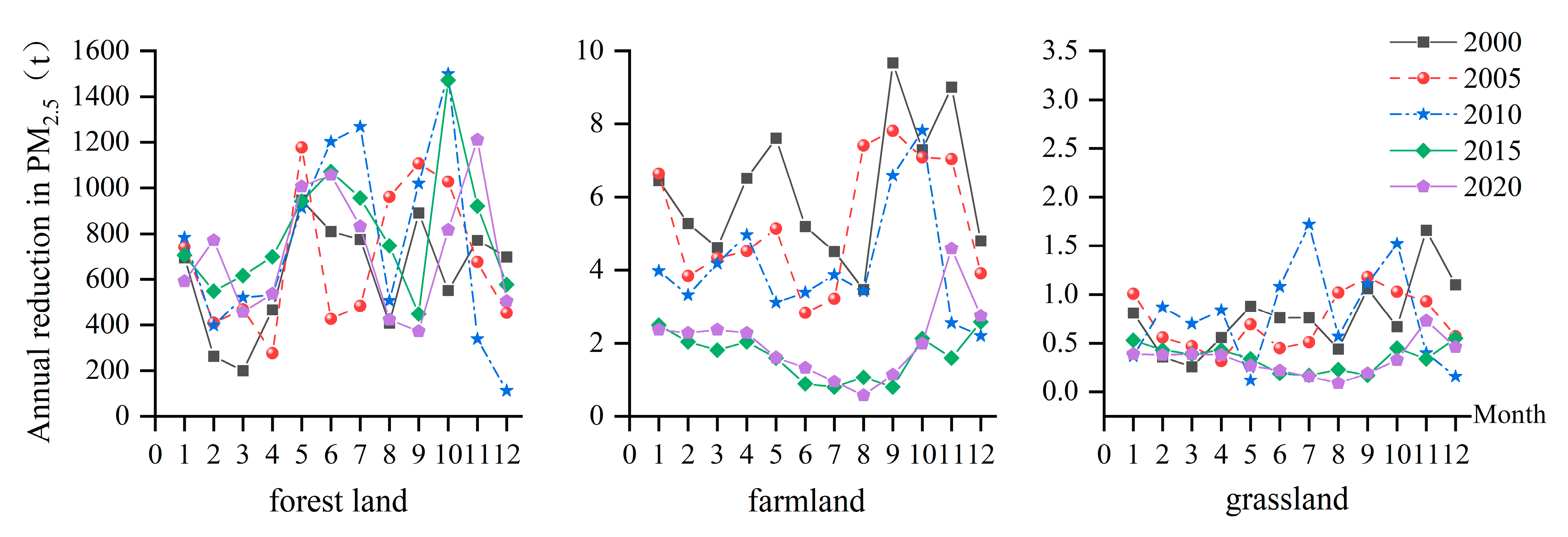
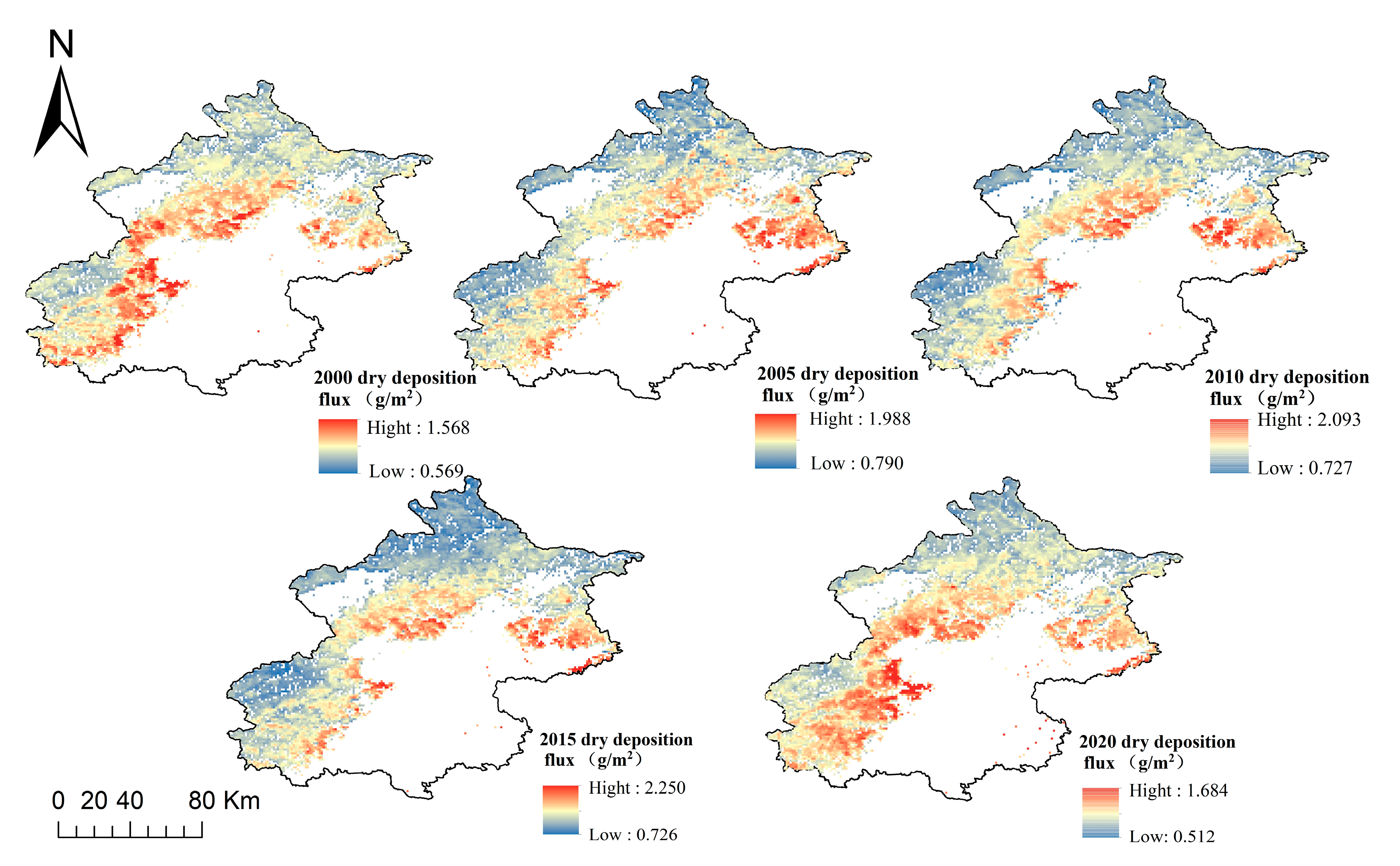
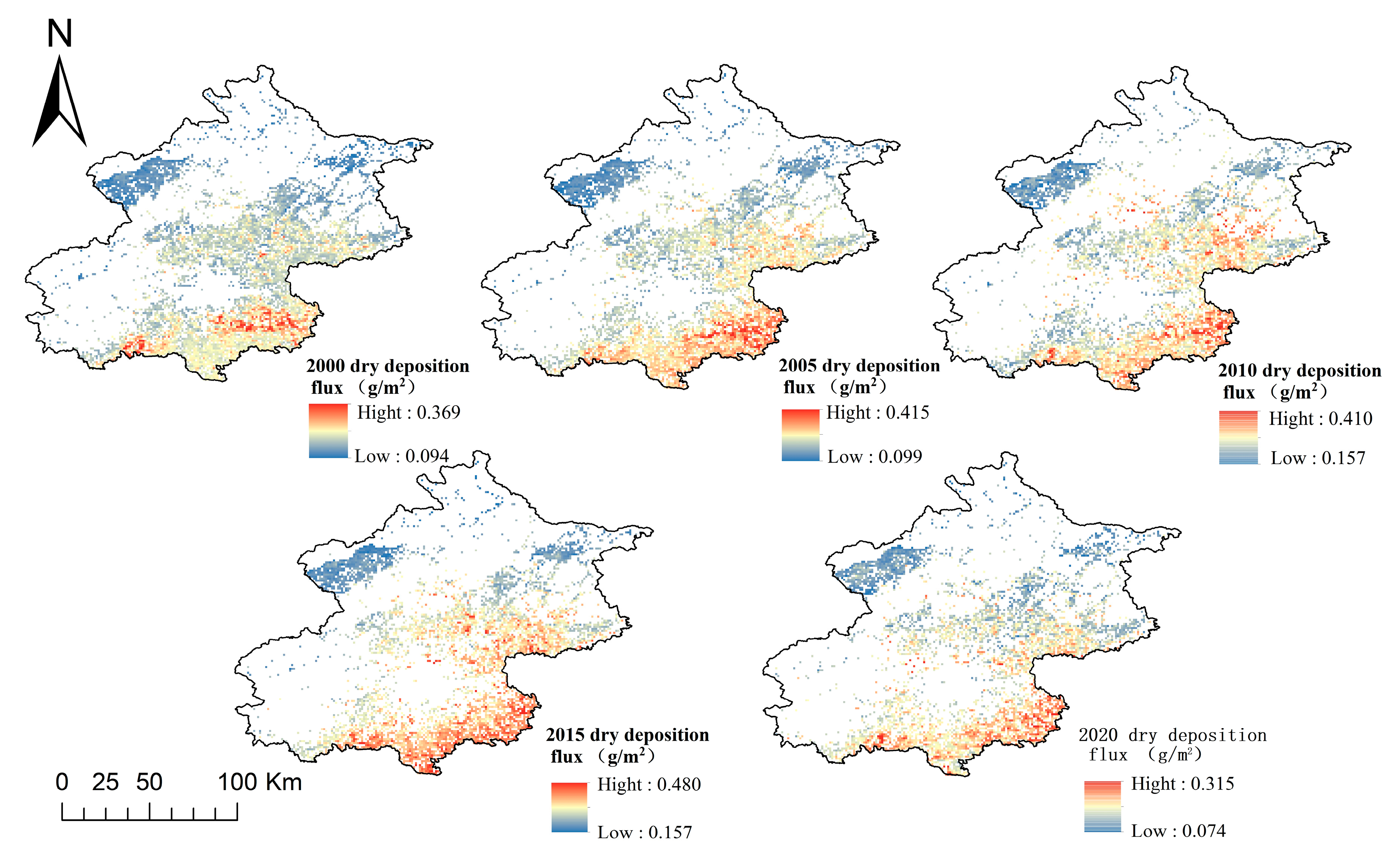
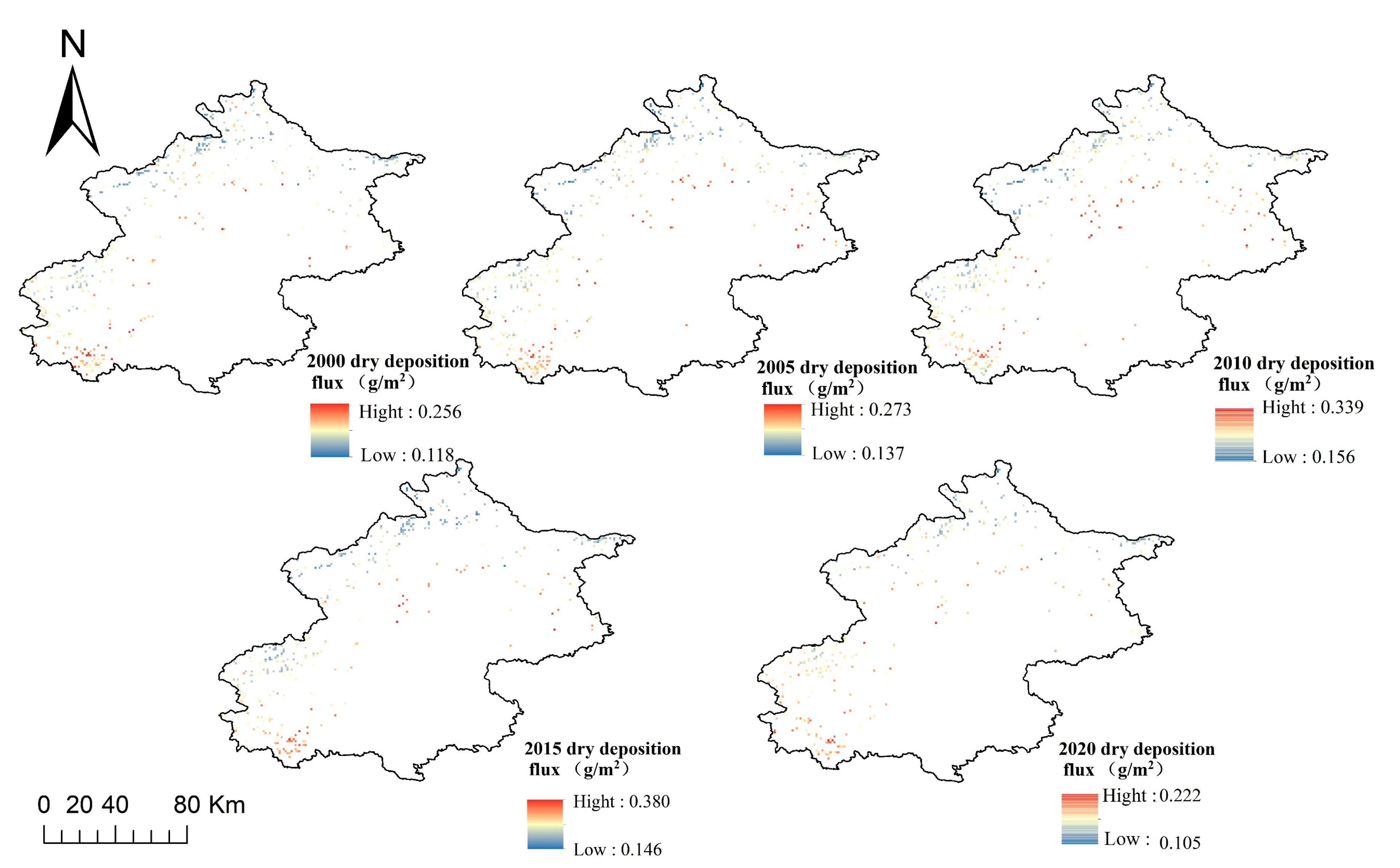
| Dry Precipitation Days (Days)/Year | Month | |||||||||||
|---|---|---|---|---|---|---|---|---|---|---|---|---|
| 1 | 2 | 3 | 4 | 5 | 6 | 7 | 8 | 9 | 10 | 11 | 12 | |
| 2000 | 23 | 15 | 13 | 20 | 16 | 14 | 14 | 7 | 19 | 19 | 26 | 24 |
| 2005 | 25 | 13 | 23 | 25 | 19 | 8 | 8 | 10 | 17 | 26 | 29 | 23 |
| 2010 | 23 | 20 | 23 | 21 | 17 | 15 | 15 | 11 | 17 | 23 | 15 | 7 |
| 2015 | 28 | 23 | 21 | 23 | 18 | 10 | 9 | 12 | 9 | 24 | 18 | 29 |
| 2020 | 25 | 24 | 25 | 24 | 17 | 14 | 10 | 6 | 12 | 21 | 27 | 29 |
| Forest Land | Farmland | Grassland | Water | Impervious Surfaces | Unutilized Land | |||||||
|---|---|---|---|---|---|---|---|---|---|---|---|---|
| a | b | a | b | a | b | a | b | a | b | a | b | |
| 2000 | 0.952 | 0.125 | 0.204 | 0.019 | 0.165 | 0.0014 | 0.006 | 0 | 0.005 | 0.00002 | 0.005 | 0 |
| 2005 | 1.234 | 0.185 | 0.236 | 0.023 | 0.192 | 0.0019 | 0.007 | 0 | 0.007 | 0.00003 | 0.006 | 0 |
| 2010 | 1.314 | 0.233 | 0.256 | 0.027 | 0.225 | 0.0026 | 0.007 | 0 | 0.007 | 0.00005 | 0.006 | 0 |
| 2015 | 1.219 | 0.247 | 0.217 | 0.024 | 0.221 | 0.0023 | 0.007 | 0 | 0.007 | 0.00006 | 0.007 | 0 |
| 2020 | 0.947 | 0.253 | 0.189 | 0.027 | 0.161 | 0.0017 | 0.005 | 0 | 0.005 | 0.00006 | 0.006 | 0 |
| average value | 1.133 | 0.209 | 0.220 | 0.024 | 0.193 | 0.002 | 0.006 | 0 | 0.006 | 0.00004 | 0.006 | 0 |
Disclaimer/Publisher’s Note: The statements, opinions and data contained in all publications are solely those of the individual author(s) and contributor(s) and not of MDPI and/or the editor(s). MDPI and/or the editor(s) disclaim responsibility for any injury to people or property resulting from any ideas, methods, instructions or products referred to in the content. |
© 2025 by the authors. Licensee MDPI, Basel, Switzerland. This article is an open access article distributed under the terms and conditions of the Creative Commons Attribution (CC BY) license (https://creativecommons.org/licenses/by/4.0/).
Share and Cite
Lei, H.; Li, S.; Duan, Y.; Xu, X.; Zhao, N.; Lu, S.; Li, B. The Dry Deposition Effect of PM2.5 in Urban Green Spaces of Beijing, China. Sustainability 2025, 17, 9608. https://doi.org/10.3390/su17219608
Lei H, Li S, Duan Y, Xu X, Zhao N, Lu S, Li B. The Dry Deposition Effect of PM2.5 in Urban Green Spaces of Beijing, China. Sustainability. 2025; 17(21):9608. https://doi.org/10.3390/su17219608
Chicago/Turabian StyleLei, Hongjuan, Shaoning Li, Yingrui Duan, Xiaotian Xu, Na Zhao, Shaowei Lu, and Bin Li. 2025. "The Dry Deposition Effect of PM2.5 in Urban Green Spaces of Beijing, China" Sustainability 17, no. 21: 9608. https://doi.org/10.3390/su17219608
APA StyleLei, H., Li, S., Duan, Y., Xu, X., Zhao, N., Lu, S., & Li, B. (2025). The Dry Deposition Effect of PM2.5 in Urban Green Spaces of Beijing, China. Sustainability, 17(21), 9608. https://doi.org/10.3390/su17219608







